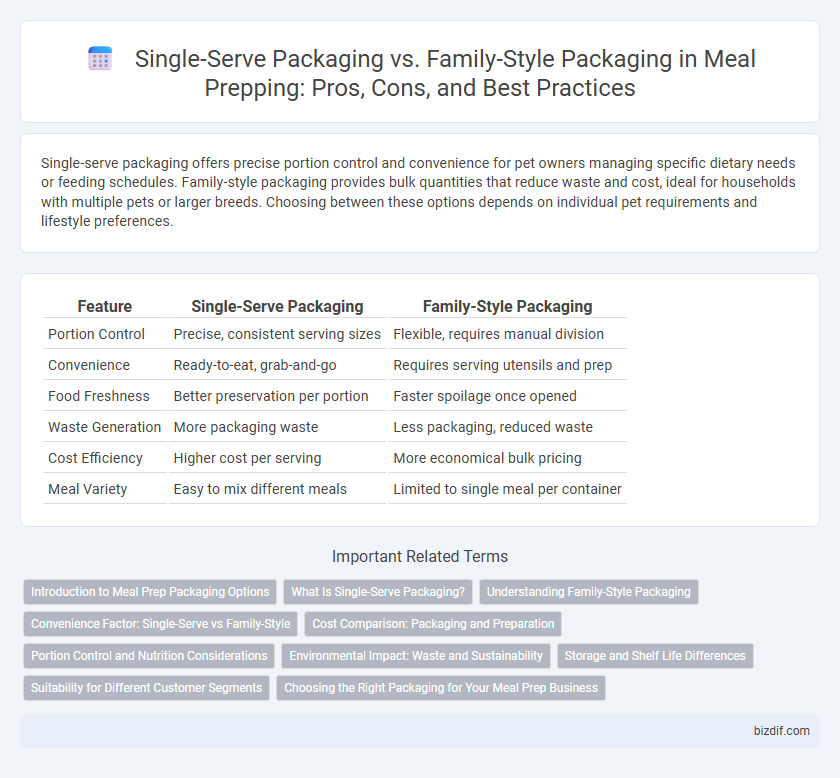Single-serve packaging offers precise portion control and convenience for pet owners managing specific dietary needs or feeding schedules. Family-style packaging provides bulk quantities that reduce waste and cost, ideal for households with multiple pets or larger breeds. Choosing between these options depends on individual pet requirements and lifestyle preferences.
Table of Comparison
| Feature | Single-Serve Packaging | Family-Style Packaging |
|---|---|---|
| Portion Control | Precise, consistent serving sizes | Flexible, requires manual division |
| Convenience | Ready-to-eat, grab-and-go | Requires serving utensils and prep |
| Food Freshness | Better preservation per portion | Faster spoilage once opened |
| Waste Generation | More packaging waste | Less packaging, reduced waste |
| Cost Efficiency | Higher cost per serving | More economical bulk pricing |
| Meal Variety | Easy to mix different meals | Limited to single meal per container |
Introduction to Meal Prep Packaging Options
Single-serve packaging offers precise portion control and convenience, ideal for individuals managing calorie intake or busy schedules. Family-style packaging maximizes efficiency by accommodating larger quantities, reducing packaging waste, and simplifying meal distribution for households. Choosing between these options depends on lifestyle, storage capacity, and meal planning goals.
What Is Single-Serve Packaging?
Single-serve packaging involves portioning meals into individual containers designed for one person, enhancing convenience and controlling calorie intake. This packaging method supports efficient meal prep by reducing food waste and simplifying storage and reheating processes. Popular in diet plans and ready-to-eat meals, single-serve packaging offers precise nutritional management and easy transportation for on-the-go lifestyles.
Understanding Family-Style Packaging
Family-style packaging streamlines meal prepping by providing bulk portions designed for multiple servings, reducing packaging waste and simplifying storage. This method enhances convenience for families or groups by allowing easy portion control and quick access to larger quantities of food. Emphasizing sustainability, family-style packaging often uses eco-friendly materials that support efficient meal planning and reduce overall plastic use.
Convenience Factor: Single-Serve vs Family-Style
Single-serve packaging offers unmatched convenience for meal prepping by allowing precise portion control, reducing food waste, and enabling quick grab-and-go options perfect for busy schedules. Family-style packaging supports larger meal quantities, fostering shared dining experiences but requires reheating and repackaging for individual consumption, which can be time-consuming. Choosing between single-serve and family-style packaging depends on lifestyle needs, with single-serve optimizing convenience for individuals and family-style benefiting households that prioritize communal meals.
Cost Comparison: Packaging and Preparation
Single-serve packaging often incurs higher per-unit costs due to increased material use and individual packaging processes, whereas family-style packaging benefits from economies of scale, significantly lowering packaging expenses. Preparation time is reduced with family-style meals, allowing bulk cooking and portioning, which minimizes labor costs compared to the repetitive handling required for single-serve portions. Cost efficiency analysis reveals family-style packaging as the more economical choice for meal prepping, especially in larger households or group settings.
Portion Control and Nutrition Considerations
Single-serve packaging enhances portion control by providing pre-measured meals that help regulate calorie intake and reduce overeating, aligning with specific dietary goals. Family-style packaging allows for more flexible meal portions but requires mindful serving to avoid excessive calorie consumption, making it less precise for strict nutritional monitoring. Choosing between these packaging styles depends on individual needs for convenience, portion accuracy, and dietary adherence.
Environmental Impact: Waste and Sustainability
Single-serve packaging generates significantly more plastic waste compared to family-style packaging, contributing to higher environmental pollution and landfill overflow. Family-style packaging reduces overall packaging materials, lowering carbon footprints and promoting sustainable meal prepping habits. Choosing bulk containers enhances waste management efficiency and supports eco-friendly food consumption practices.
Storage and Shelf Life Differences
Single-serve packaging for meal prepping enhances portion control and reduces exposure to air, significantly extending shelf life by minimizing oxidation and bacterial growth. Family-style packaging, while more space-efficient for bulk storage, often results in quicker spoilage once opened due to repeated exposure to contaminants and fluctuating temperatures. Utilizing airtight, vacuum-sealed materials in single-serve containers further optimizes freshness and storage duration compared to traditional family-style containers.
Suitability for Different Customer Segments
Single-serve packaging caters to busy individuals and single-person households by providing convenience, portion control, and reduced food waste. Family-style packaging suits larger households and gatherings, offering cost-effectiveness and ease of sharing multiple servings. Choosing between these packaging types depends on customer lifestyle, household size, and consumption preferences.
Choosing the Right Packaging for Your Meal Prep Business
Single-serve packaging offers convenience and precise portion control, ideal for customers seeking quick, ready-to-eat meals or calorie management. Family-style packaging reduces waste and lowers costs by providing larger quantities suitable for communal dining, appealing to families or bulk buyers. Selecting the right packaging depends on your target market's preferences, storage capabilities, and distribution methods to optimize freshness and customer satisfaction.
Single-Serve Packaging vs Family-Style Packaging Infographic

 bizdif.com
bizdif.com